No. 1: Nole Takes the Long Way
By Steve Tignor Dec 12, 2014Play suspended in Barcelona when the wrong racquet gets taken for stringing
By Liya Davidov Apr 17, 2025Serena Williams named to Time's 100 most influential people ... and Coco Gauff approves!
By Baseline Staff Apr 17, 2025Jelena Ostapenko tops Emma Navarro for Iga Swiatek Stuttgart clash; Coco Gauff, Jessica Pegula roll
By TENNIS.com Apr 17, 2025Who is Diego Dedura-Palomero? Meet Germany’s latest teenage star
By Emma Storey Apr 17, 2025Rafael Nadal to be honored with 'exceptional' tribute on opening day of Roland Garros
By Associated Press Apr 17, 2025Mirra Andreeva belts 'Happy Birthday' song to coach Conchita Martinez in Stuttgart
By Baseline Staff Apr 16, 2025Ben Shelton uses altitude to his advantage, joins Alexander Zverev in Munich quarterfinals
By TENNIS.com Apr 16, 2025Iga Swiatek in Stuttgart: From clay court to carpool karaoke!
By Franziska Bruells Apr 16, 2025Thorne taps Ben Shelton to launch new on-the-go performance line
By Stephanie Livaudais Apr 16, 2025No. 1: Nole Takes the Long Way
Novak Djokovic's five-set win over Roger Federer at Wimbledon was
Published Dec 12, 2014
Advertising
What was the measure of a great tennis match in 2014? It was too hard to win the first time around. Yesterday, in our No. 2 contest of the year, we watched as Maria Sharapova snatched defeat from the jaws of victory in the French Open final, before snatching the title back again at the last minute. Today we’ll see the same phenomenon in our top match of 2014, the Wimbledon men’s final. On that bright July day on Centre Court, Novak Djokovic had it, blew it, and finally won it, 6-7 (7), 6-4, 7-6 (4), 5-7, 6-4, over Roger Federer.
The season reached its peak during those four hours in London, as Djokovic-Federer joined the long list of all-time classic finals at Wimbledon. The match wasn’t just the best of the year, it was also the most consequential: If Federer had won the fifth set, he, rather than Djokovic, would have finished the season at No. 1. Not many matches live up to their setting and their expectations; this one exceeded them.
For those who have forgotten, here’s a look at the 30-minute highlight-reel reminder above.
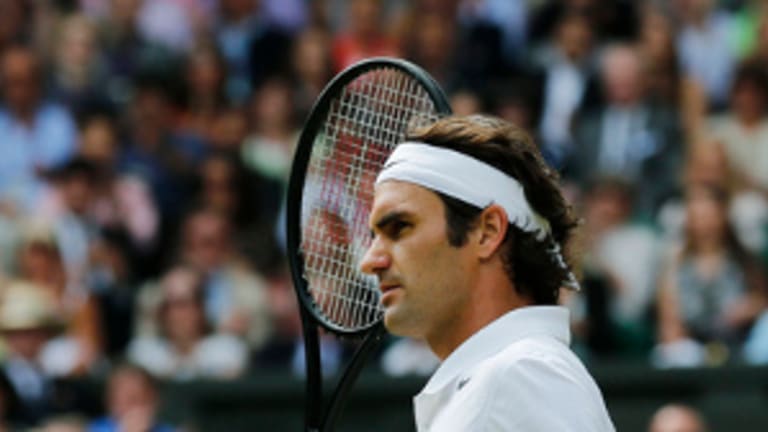
No. 1: Nole Takes the Long Way
© AP
Advertising
—Judging from the crowd reaction to Federer’s early drop-volley winner, this appears to be a heavily pro-Roger audience. And it is: I’ve never heard a sustained buzz in Centre Court like the one that built up during Federer’s fourth-set comeback, or a roar as loud as the one that greeted his overhead winner near the end of that set.
From where I was sitting that day, though, you could hear significant support for Djokovic as well—Nole, always sensitive to a crowd’s likes and dislikes, was grateful for it afterward. The audience was there to see Federer win, but they were there for the occasion as well; they were there to see a classic. In that sense, the ATP’s Golden Era has spoiled us; we now expect the epic. And the Big 4 continue to live up to those expectations.
—The first set was the best of them all. Both players were crisp, and they kept fierce hold of their serves—the opening points are an alert that the stakes are high, and the quality is going to be appropriately high as well. This wasn’t surprising from Federer’s side; he had been nearly flawless during the fortnight, losing just one set before the final and dismantling a deer-in-the-headlights Milos Raonic in the semifinals. But the strong early play was a surprise from Djokovic. He had struggled mightily to get to the final, going five sets with Marin Cilic in the quarters and barely avoiding a fifth with Grigor Dimitrov in the semis.
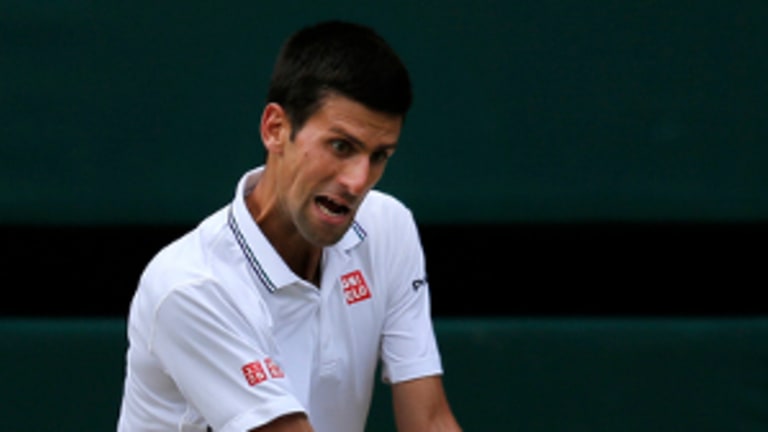
No. 1: Nole Takes the Long Way
© AP
Advertising
Djokovic had been quick to anger and show his frustration in those matches. That wasn’t the case here; he knew he needed to play with more calm if he was going to weather Federer's trademark first-set storm. What was even more surprising was how long Djokovic stayed on his feet in the early going. He had slipped and slid his way all over Centre Court in the semis; here his tumbles are much fewer and farther between. As for Federer, it’s hard to imagine him ever being laid out flat on the court. Staying upright seems to be a matter of pride, as much as good footwork, with him.
—Two days ago, in writing about the Petra Kvitova-Venus Williams match at Wimbledon this year, I said that sometimes the sun there goes in and out above Centre Court until it decides to stick around and see what happens. Here the sun is out to stay by the end of the first set, just as Djokovic and Federer engage in two 20-shot rallies.
Writing about Kvitova-Venus, I also wondered how we can say the grass is “too slow” these days, when it can produce a match as fast-paced and high-quality as that one was. The same holds true for Djokovic-Federer. Yes, the players are at the baseline much of the time, but there’s a sense of danger and anticipation in every stroke, because an attack is always imminent. Between the two of them, Djokovic and Federer came to the net 102 times. Listen to the scratchy pitter-patter they make with their sneakers: The tension isn’t just palpable, it’s audible.
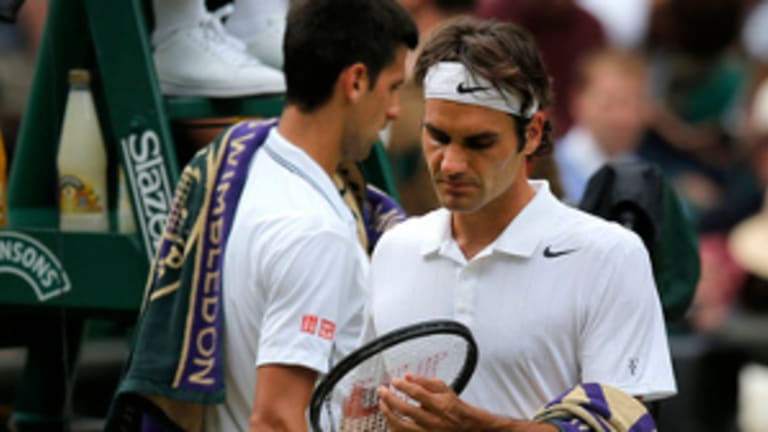
No. 1: Nole Takes the Long Way
© AP
Advertising
—Federer escapes a set point to win the first, but I can remember thinking that Djokovic had proved just as much by the way he had played, and the way he had handled himself, in that set. Because of its setting, this match can be compared to the two greatest Wimbledon men’s finals of recent vintage—1980 and 2008, when the winners, Bjorn Borg and Rafael Nadal, squandered match points in the fourth before winning in the fifth. And this one does belong in that company. Afterward, Djokovic said, “I’ve had the longest final, against Nadal in the Australian Open in 2012. But quality-wise, from first point to last, this is definitely the best match.”
But it also bears a strong resemblance to a less-memorable contest, Andy Murray’s win over Federer in the Aussie Open semifinals in 2013. That time, Murray had set points in all five sets, just as Djokovic does here. That time, Federer, spurred by the crowd, made a desperately brilliant run to stave off defeat in the fourth before finally caving in the fifth, just as he does here. Even when a top player is at his best, it's still tough to finish Federer off.
—The match shifts in Djokovic’s direction when he breaks for 2-1 in the second set. Fittingly, he does it with a backhand pass. Watching this clip, it can almost seem like Federer is facing that shot alone. With it, Djokovic creates sharp angles, dipping passes, tough lobs, and running down-the-line passes that have Federer yelling “Aiyiyi,” in despair. Later, Djokovic said he was prepared to hit that shot.
“I’ve seen a couple of his matches here,” Djokovic said of Federer. “He’s coming to the net more often. He’s playing down-the-line backhands more than he has been in recent years. Those were particular changes in his game that I noticed before coming to this match. I paid attention to it and was ready for it.”

No. 1: Nole Takes the Long Way
© AP
Advertising
—I wrote at the time that the two most important shots in the match were Federer's serve and his return—one kept him in it, the other kept him out of it. He had 29 aces, including five in a row at one stage. You don’t see it here, but after one of Federer’s service winners wiped away a break point, Djokovic took out his frustration by screaming at the service line. He seemed to be asking: Why are you sitting right where Federer is serving the ball, every time?
Federer’s return, though, was a different story.
“I couldn’t figure out why I wasn’t breaking Novak’s serve,” Federer said, “or actually creating opportunities. He was doing a good job with his serve.”
—In retrospect, you can see in the highlights that there were a couple of moments when the match could have gone the other way—there usually are on grass. Serving at 5-4 in the second set, Djokovic faces a break point. But he comes up with a good body serve, and finishes the point with an easy forehand winner. In the third set, Djokovic serves at 4-5, 15-0, and is forced to hit an amazing short-hop, swipe forehand pass. If those two points go the other way, the match might as well.
—The floodgates finally open for Federer in the fourth, when he breaks Djokovic three times. If he had gone on to win, his challenge at match point down might have become the most famous replay in tennis history. Djokovic shows his frustration when the call is overturned, and he's visibly slumped by the time the set is over. A month earlier, he had played poorly and lost the French Open final to Nadal, and that failure could have weighed on him here. But he didn’t let it.
“I could easily have lost my concentration in the fifth and just handed him the win,” Djokovic said. “But I didn’t, and that’s why this win has a special importance to me mentally. Because I managed to not just win against my opponent, but win against myself.”
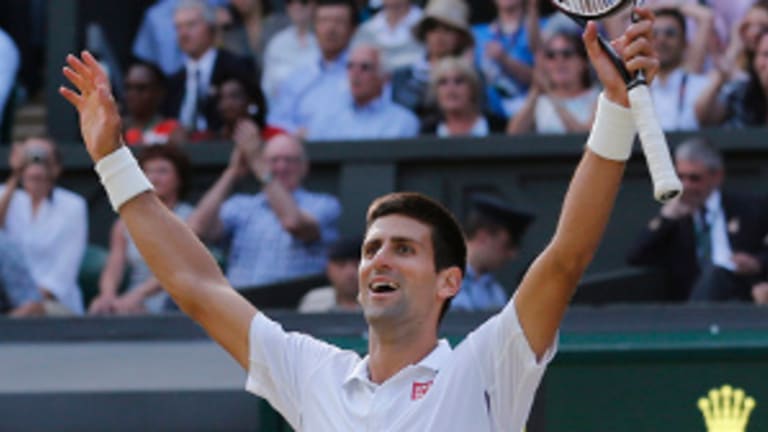
No. 1: Nole Takes the Long Way
© AP
Advertising
—After fighting uphill for four hours, Federer’s level finally slipped at 4-5 in the fifth. He missed his first serves, and four unforced errors followed. It was an anti-climax, but has any player provided as much entertainment on Centre Court as Federer? He has won two classic five-set finals, in 2007 and 2009, and lost two, in 2008 and 2014. At 33, Federer still has the game and the aura of his dominant days, but now it’s mixed with the vulnerability of age—no wonder the crowds, at Wimbledon and elsewhere, cheer louder than ever for him. When this one was over, a single tear rolled down his cheek.
—At the end, Djokovic walked into the stands and wrapped his coaches, most prominently Boris Becker, in a bear hug. By all accounts, Becker did what he was hired to do at Wimbledon. He said he emphasized “clarity of thought and avoidance of panic” and tried to install “the ability to withstand pressure and decide on solutions on the run.” That’s pretty much how Djokovic won his last two matches on Centre Court.
Yet it was another coach who Djokovic had on his mind that day. He dedicated the win to his first mentor, Jelena Gencic, the woman who had made him believe that he would—not could, would—be No. 1 someday. This was Djokovic's first major title since her death in May 2013, and during that time he seemed to search in vain for the confidence that she had given him. At Wimbledon, he found it, and in the process he reclaimed the No. 1 ranking that she had promised. After Djokovic was done hugging Becker, he walked back down onto the court, pointed to the heavens, and lifted his hands in a short prayer. Someone, he found out again that afternoon, was still watching over him.
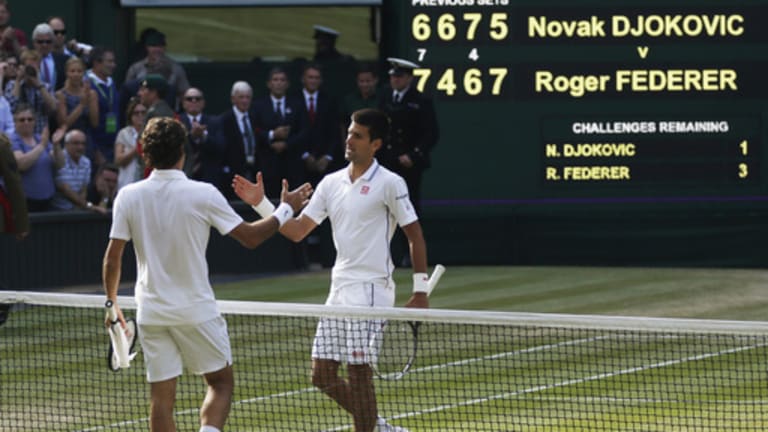
No. 1: Nole Takes the Long Way
© AP
Advertising
**No. 1: Djokovic d. Federer at Wimbledon
No. 2: Sharapova d. Halep at Roland Garros
No. 3: Kvitova d. V. Williams at Wimbledon
No. 4: S. Williams d. Wozniacki at WTA Finals
No. 5: Wawrinka d. Djokovic at Australian Open
No. 6: Murray d. Robredo at Valencia
No. 7: Federer d. Wawrinka at ATP World Tour Finals
No. 8: Federer d. Monfils at U.S. Open
No. 9: Kvitova d. Kerber at Fed Cup
No. 10: Nishikori d. Ferrer at Madrid**